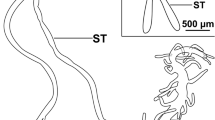Summary
The salivary glands of the moth,Manduca sexta, are described, emphasizing correlations between structure and function in an attempt to explain the production of a dilute saliva. Each of the paired glands consists of five distinct regions: protein secreting, fluid secreting, thin duct, bulbous duct, and common duct. Each region constists of a single, ultrastructurally distinct, cell type. It is proposed that the protein and fluid secreting regions produce an enzyme-containing primary saliva isosmotic with the haemolymph; this saliva is modified in the remaining regions of the gland to yield a dilute saliva.
Similar content being viewed by others
References
Berridge, M. J., Gupta, B. L.: Fine-structural changes in relation to ion and water transport in the rectal papillae of the blowfly,Calliphora. J. Cell Sci.2, 89–112 (1967)
Bland, K. P., House, C. R.: Function of the salivary glands of the cockroach,Nauphoeta cinerea. J. Insect Physiol.17, 2069–2084 (1971)
Copeland, D. E.: A mitochondrial pump in the cells of the anal papillae of mosquito larvae. J. Cell Biol.23, 253–263 (1964)
Dahlman, D. L.: Trehalase activity in tobacco hornworm tissue. Ann. entomol. Soc. Amer.63, 1563–1565 (1970)
Diamond, J. M.: Water-solute coupling and ion selectivity in epithelia. Phil. Trans. B262, 141–151 (1971)
Diamond, J. M., Bossert, W. H.: Standing-gradient osmotic flow. A mechanism for coupling of water and solute transport in epithelia. J. gen. Physiol.50, 2061–2083 (1967)
Kendall, M. D.: The fine structure of the salivary glands of the desert locustSchistocerca gregaria Forskâl. Z. Zellforsch.98, 399–420 (1969)
Kessel, R. G., Beams, H. W.: Electron microscope observations on the salivary gland of the cockroach,Periplaneta americana. Z. Zellforsch.59, 857–877 (1963)
Maser, M. D., Powell, T. E., Philpott, C. W.: Relationships among pH, osmolality, and concentration of fixative solutions. Stain Technol.42, 175–182 (1967)
Oschman, J. C., Berridge, M. J.: Structural and functional aspects of salivary gland secretion in Calliphora. Tissue and Cell2, 281–310 (1970)
Oschman, J. C., Wall, B. J.: The structure of the rectal pads of Periplaneta americana L. with regard to fluid transport. J. Morph.127, 475–509 (1969)
Revel, J. P., Karnovsky, M. J.: Hexagonal array of subunits in intracellular junctions of the mouse heart and liver. J. Cell Biol.33, C7-C12 (1967)
Reynolds, E. S.: The use of lead citrate at high pH as an electron-opaque stain in electron microscopy. J. Cell Biol.17, 208–212 (1963)
Richardson, K. C.: Electron microscopic identification of autonomic nerve endings. Nature (Lond.)210, 756 (1966)
Robertson, H. A.: The innervation of the Salivary gland of the moth,Manduca sexta. Z. Zellforsch. (in press)
Wigglesworth, V. B.: The principles of insect physiology, 6th ed. London: Methuen 1965
Yamamoto, R. T.: Mass rearing of the tobacco hornworm-1. Egg production. J. econ. Ent.61, 170–174 (1968)
Yamamoto, R. T.: Mass rearing of the tobacco hornworm-11. Larval rearing and pupation. J. econ. Ent.62, 1427–1431 (1969)
Young, J. A., Fromter, E., Schogel, E., Hamann, K. F.: Micropuncture and perfusion studies of fluid and electrolyte transport in the rat submaxillary gland. In: Secretory mechanisms of salivary glands (Schneyer and Schneyer eds.), p. 11–31. New York-London: Academic Press 1967
Author information
Authors and Affiliations
Additional information
Acknowledgements. We thank Professor T. Weis-Fogh for accommodation in the Department of Zoology and Dr. J. E. Treherne for use of A.R.C. facilities. We are especially grateful to Dr. Nancy Lane for encouragement, advice and critical comments and to Drs. M. J. Berridge and S.H.P. Maddrell for helpful discussion. H.A.R. is grateful to Clare College, Cambridge for financial aid.
Rights and permissions
About this article
Cite this article
Leslie, R.A., Robertson, H.A. The structure of the salivary gland of the moth (Manduca sexta). Z.Zellforsch 146, 553–564 (1973). https://doi.org/10.1007/BF02347183
Received:
Issue Date:
DOI: https://doi.org/10.1007/BF02347183




